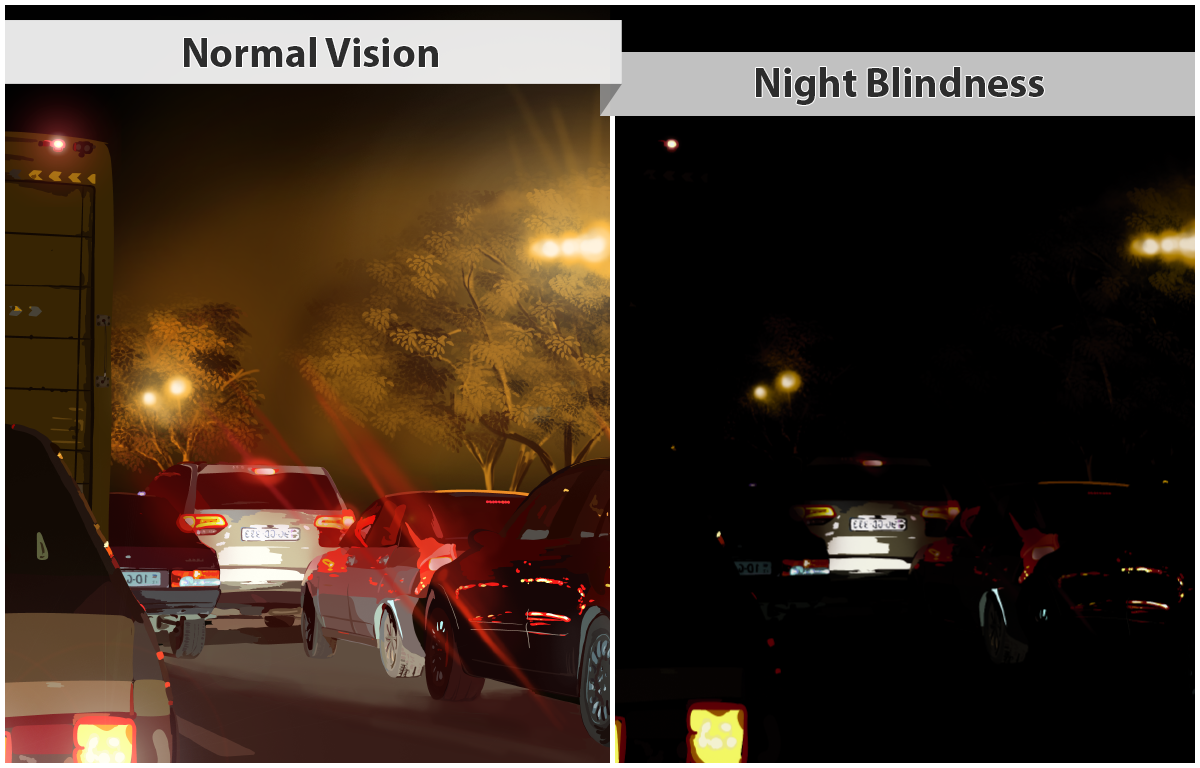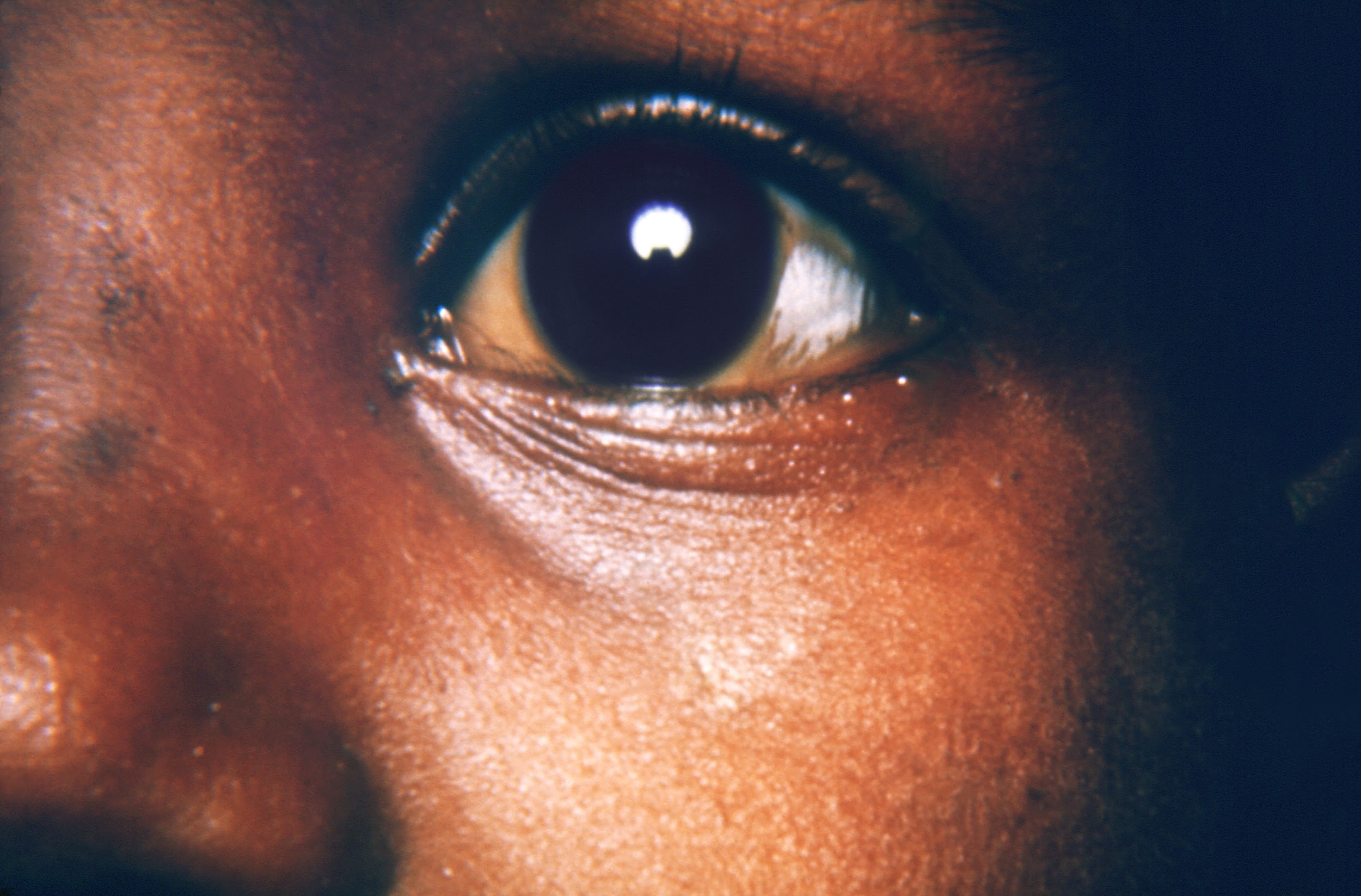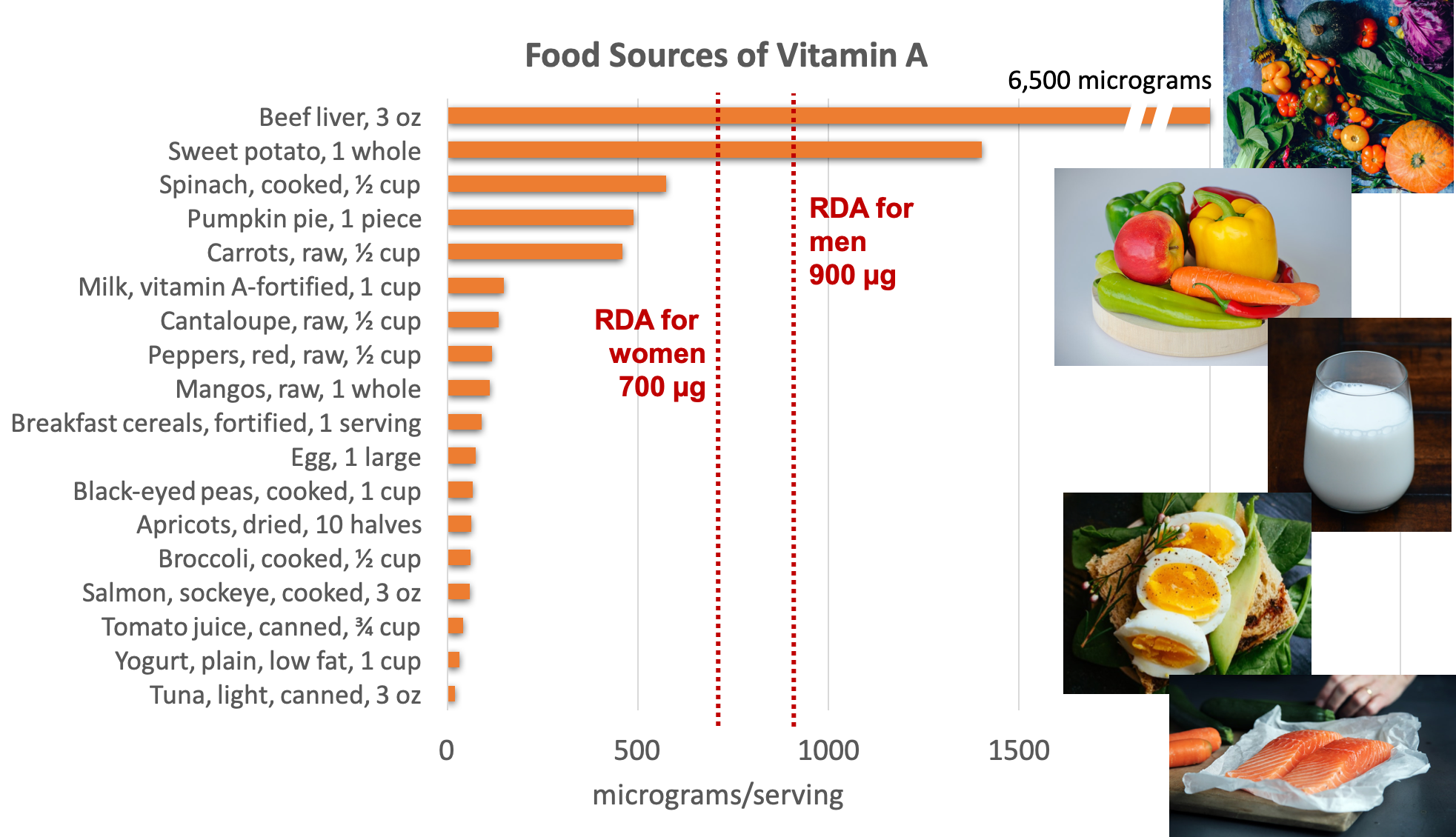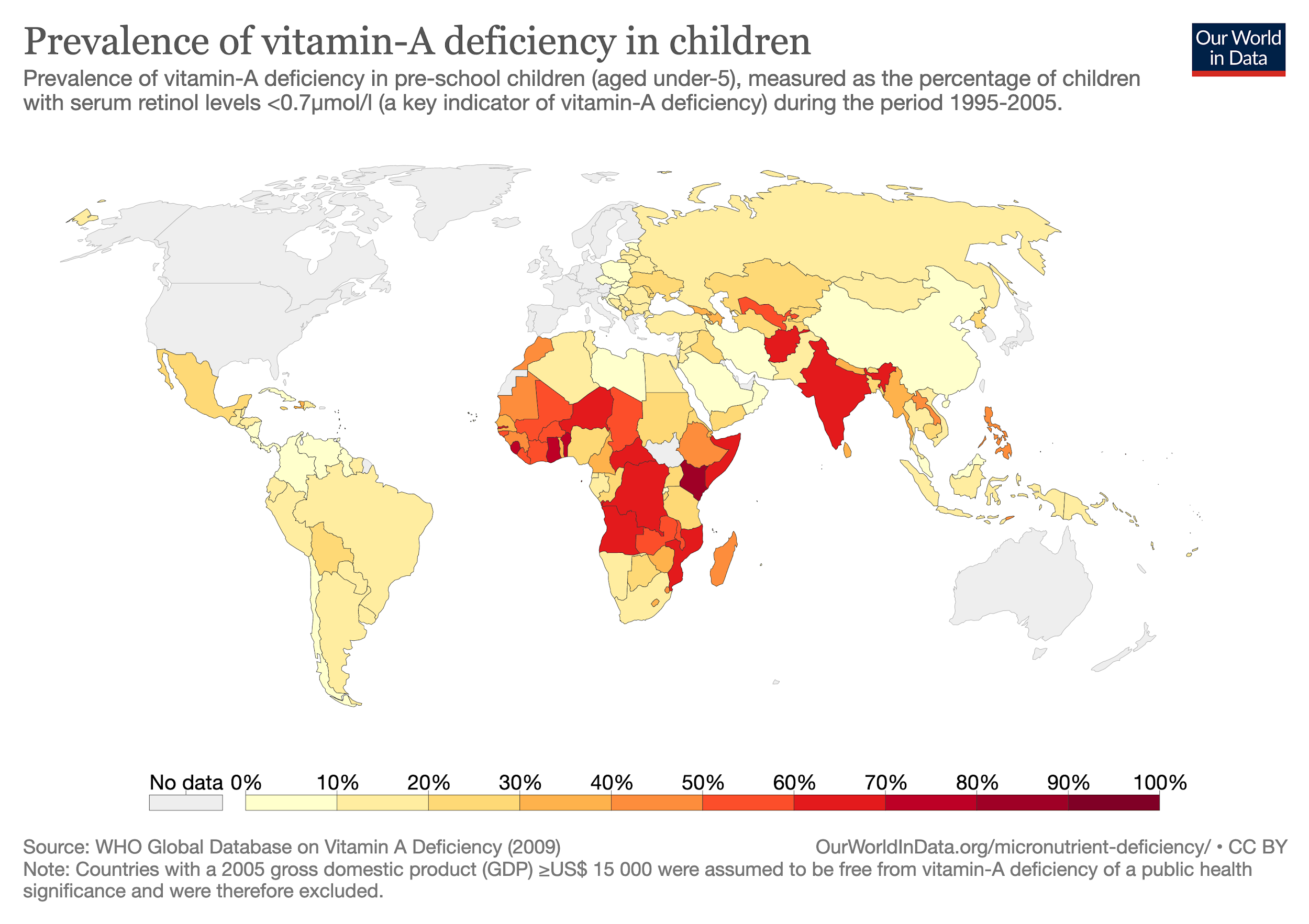Unit 8 – Vitamins and Minerals Part 1
8.7 Vitamin A’s Role in Vision
Vision is one of our five basic senses; unless you’ve experienced vision loss, it’s hard to imagine life without sight. Vitamin A plays a key role in vision and eye health. This page will cover the functions, food sources, and signs of deficiency and toxicity for vitamin A and carotenoids, such as beta-carotene, which can be converted to vitamin A.
Vitamin A
Vitamin A is a generic term for a group of similar compounds called retinoids. Retinol is the form of vitamin A found in animal-derived foods, and it is converted in the body to the biologically active forms of vitamin A,
This differentiates it from beta-carotene and other carotenoid compounds, brightly colored yellow, orange, and red pigments synthesized by plants. These are called provitamin A carotenoids because they can be converted to vitamin A in the body. Among the carotenoids, beta-carotene is most efficiently converted to vitamin A.
The retinoids are aptly named, as their most notable function is in the eye’s retina. Retinol circulating in the blood is taken up by the retina, where it’s incorporated into the rhodopsin pigment. Rhodopsin is especially important to our ability to see in low-light conditions. Low rhodopsin levels impair vision in dim light, a condition known as night blindness.

Vitamin A is also required for normal cell differentiation, important in every tissue of the body. If there is a shortage of vitamin A, the eye is one of the first areas to be impacted. Cells in the eye lining produce mucus and tears, which keep eyes moist and lubricated. Lack of vitamin A results in dry eyes, a condition called xerophthalmia. Instead of producing mucus, these dysfunctional cells produce a protein called keratin. Keratin is a hard, structural protein found in nails, hair, and the outer layer of skin, and you can imagine the problems it causes when it accumulates in the eye. Instead of a moist, well-lubricated eye, keratin makes the eye hard and dry, resulting in clouded vision. A deficiency in vitamin A can thus impair vision in two ways:
1. Development of night blindness due to a lack of the pigment rhodopsin
2. Development of xerophthalmia, or dry eyes, caused by abnormal cellular differentiation

Figure 8.16. A child with xerophthalmia caused by vitamin A deficiency, demonstrating cloudiness on the surface of the eye.
Night blindness is usually the first sign of a vitamin A deficiency, followed by xerophthalmia and clouded vision. If the deficiency persists, the damage from keratin in the lining of the eye can cause permanent blindness.
Vitamin A’s role in cellular differentiation also makes it critical to cells around the body involved in normal growth, development, reproduction, and immune function.
Food Sources of Vitamin A and Carotenoids
Preformed vitamin A is found only in animal-derived foods. The best food sources are liver and fish oils, as vitamin A is fat-soluble and stored in fatty tissues. Smaller amounts can be found in other animal products, such as meat, eggs, and dairy products.
Provitamin A carotenoids such as beta-carotene are mostly found in fruits and vegetables. Carotenoids are brightly-colored pigments, so vibrant color is a good indicator of their presence. Top sources include orange and yellow vegetables such as carrots, sweet potatoes, pumpkins (beta-carotene is a bright orange pigment), bell peppers, fruit, leafy green vegetables, and some vegetable oils. Some carotenoids can also be found in animal-derived foods. For example, the yellow color of egg yolk and butter comes from carotenoids absorbed from the diets of the hens and cows, respectively.

Figure 8.17. Food sources of vitamin A. Source: NIH Office of Dietary Supplements.
Deficiency and Toxicity of Vitamin A and Carotenoids
Another symptom of vitamin A deficiency is hyperkeratosis, which occurs when cells in the skin overproduce the protein keratin (similar to what happens in the eye with xerophthalmia), causing the skin to become rough and irritated.
Vitamin A deficiency is rare in developed countries, but globally, it is the leading cause of preventable blindness in children. According to the World Health Organization, an estimated 250,000 to 500,000 children lose sight each year due to vitamin A deficiency, and half die within a year of developing blindness, likely due to infection.2 According to UNICEF, 30% of children under 5 have vitamin A deficiency worldwide.4

Vitamin A toxicity causes dry, itchy skin, loss of appetite, dizziness, nausea, swelling of the brain, and joint pain. It can cause liver damage, coma, and death in the most severe cases. Vitamin A toxicity is almost always caused by taking supplements in doses above the UL of 3,000 micrograms per day for substantial periods. These high doses would not be found in a normal diet, although vitamin A toxicity has been observed in Arctic explorers who ate large amounts of bear and seal liver.4
Consuming excessive amounts of vitamin A during pregnancy can also cause birth defects, so pregnant people should pay close attention to vitamin A in supplements. In addition, some synthetic forms of vitamin A (Retin-A and Accutane, for example) are used as acne treatments and should never be used during pregnancy due to the risk of birth defects.
Beta-carotene and other carotenoids do not seem to cause birth defects or other major toxicity effects in high doses. This is because the body doesn’t convert beta-carotene to vitamin A if it already has excessive amounts of vitamin A. Because it doesn’t cause toxicity, beta-carotene is usually used as the source of vitamin A in prenatal multivitamin supplements.
A diet high in beta-carotene can have the unusual effect of making a person’s skin appear yellow or orange. The color change doesn’t seem harmful, and normal skin tone returns once the person stops consuming so much beta-carotene.
Self Review Questions
Attributions:
- Lane Community College’s Nutrition: Science and Everyday Application CC BY-NC.4
- Zimmerman, M., & Snow, B. Nutrients Important as Antioxidants. In An Introduction to Nutrition (v. 1.0). https://2012books.lardbucket.org/books/an-introduction-to-nutrition/index.html, CC BY-NC-SA 3.0
- Lindshield, B. (2018). Kansas State University Human Nutrition (FNDH 400) Flexbook. NPP eBooks. https://newprairiepress.org/ebooks/19
References:
- 1Sommer, A. (2008). Vitamin a deficiency and clinical disease: An historical overview. The Journal of Nutrition, 138(10), 1835–1839. https://doi.org/10.1093/jn/138.10.1835
- 2World Health Organization. (n.d.). Micronutrient deficiencies. WHO; World Health Organization. Retrieved April 7, 2020, from https://www.who.int/nutrition/topics/vad/en/
- 3United Nations Children’s Fund. (2020). Estimates of Vitamin A Supplementation Coverage in Preschool-age Children: Methods and processes for the UNICEF global database. UNICEF.
- 4National Institutes of Health Office of Dietary Supplements. (n.d.). Vitamin A. Retrieved April 7, 2020, from https://ods.od.nih.gov/factsheets/VitaminA-HealthProfessional/
- 5Higdon, J., Drake, V. J., & Delage, B. (2014, April 28). Carotenoids. Linus Pauling Institute. https://lpi.oregonstate.edu/mic/dietary-factors/phytochemicals/carotenoids
- Image Credits:
- Figure 8.15. “Depiction of vision of a person suffering from night blindness “ by Upchar is licensed under CC BY-SA 4.0
- Figure 8.16. “Eye with xerophthalmia “ by CDC/ Dr. J. Justin Older is in the Public Domain
- Figure 8.17. “Food sources of Vitamin A” by Alice Callahan is licensed under CC BY 4.0, with images from top to bottom by Ella Olsson, Alexander Schimmeck, Kim Gorga, Joseph Gonzalez, Caroline Attwood on Unsplash (license information)
- Figure 8.18. “Prevalence of vitamin-A deficiency in children” by Our World in Data is licensed under CC BY 4.0
The process in which a cell changes from one cell type to another. Usually, the cell changes to a more specialized type.

